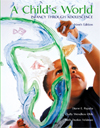 |  A Child's World: Infancy through Adolescence, 9/e Diane E. Papalia,
University of Wisconsin-Madison
Sally Wendkos Olds
Ruth Duskin Feldman
Psychosocial Development in Adolescence
Learning Objectives
LEARNING OBJECTIVES FOR SECTION IAfter reading and reviewing this section of Chapter 17, you should be able to
do the following.
Discuss how identity formation occurs in adolescence, according to Erikson,
and name the three main issues involved in the identity crisis.
Name the two elements that determine identity status, according to Erikson
and James Marcia, and describe four categories of identity status identified
by Marcia.
Compare Erikson's, Marcia's, and Gilligan's views on gender differences
in identity formation, and summarize research findings on how gender affects
self-esteem.
Explain how ethnicity can complicate identity formation for young people
in minority groups.
|
 |  |  | LEARNING OBJECTIVES FOR SECTION IIAfter reading and reviewing this section of Chapter 17, you should be able to
do the following.
Name three difficulties of studying adolescents' sexuality.
Discuss the reasons for, and effects of, the evolution in sexual behavior
and attitudes among adolescents in recent years.
Identify three patterns of risky sexual behavior, and three major risks
that accompany it.
Discuss reasons for early sexual activity and factors that influence
its likelihood.
Identify trends in contraceptive use and characteristics of adolescents
who do not use reliable protection when engaging in sexual behavior.
Discuss the connection between sexual knowledge and rates of sexual
activity, and compare the effectiveness of knowledge gained from parents or
other adults, from formal instruction, and from the media.
Give at least two reasons for the high teenage pregnancy rates in the
United States as compared with most Western European industrialized countries,
discuss implications for public policy, and describe a promising pregnancy
prevention program.
Identify characteristics of teenagers who are likely to become pregnant
and of the fathers of babies born to teenage mothers.
Describe trends in teenage pregnancy and birth rates among married and
unwed girls.
Identify the practical and emotional needs of expectant teenagers,
and ways of helping them adjust to parenthood.
Cite problems that contribute to poor outcomes of teenage pregnancy
for mothers and children.
Discuss benefits and drawbacks of a teenage mother's living with her
own mother.
|
 |  |  | LEARNING OBJECTIVES FOR SECTION IIIAfter reading and reviewing this section of Chapter 17, you should be able to
do the following.
Evaluate the validity of the concept of adolescent rebellion, and explain
the danger of assuming that adolescent turmoil is normal and necessary.
Describe cross-cultural research on the continuity of personality types
from childhood through adolescence.
Tell how teenagers typically allocate their time, particularly the changes
in time spent with family and peers; and point out cultural differences.
Describe the typical nature and extent of adolescent conflict with parents
and its course from early to late adolescence, and point out ethnic variations.
Discuss the relationship between family atmosphere, parenting styles,
and family conflict, and identify the kind of parenting that seems to best
meet adolescents' needs.
Assess effects of parents' employment on adolescents.
Assess the effects of family structure and economic stress on adolescents'
well-being.
Describe changes in sibling relationships during adolescence and cite
factors that may influence the quality of these relationships.
Identify five peer status groups, and tell which groups have the greatest
adjustment problems.
Tell how friendship in adolescence differs from friendship during childhood,
and cite factors affecting its quality.
Tell how parental and peer influences interact, from early childhood
on, to promote antisocial or delinquent behavior.
Cite factors affecting the likelihood that antisocial teenagers will
become chronic delinquents or hard-core criminals.
Discuss the impact of early childhood intervention in preventing delinquency.
|
 |  |  | LEARNING OBJECTIVE FOR SECTION IVAfter reading and reviewing this section of Chapter 17, you should be able to
do the following.
Discuss findings of cross-cultural studies of adolescents' attitudes
and self-image.
|
|



 2002 McGraw-Hill Higher Education
2002 McGraw-Hill Higher Education